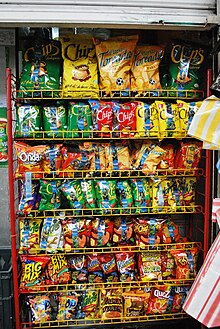
Back طعام سهل التحضير Arabic Кулінарныя паўфабрыкаты Byelorussian Convenience Food German Plato preparado Spanish غذای آماده Persian Eines Finnish Kényelmi élelmiszerek Hungarian Alimento pronto Italian 간편식 Korean Тав тухтай хоол Mongolian

Convenience food (also called tertiary processed food) is food that is commercially prepared (often through processing) for ease of consumption, and is usually ready to eat without further preparation. It may also be easily portable, have a long shelf life, or offer a combination of such convenient traits. Convenience foods include ready-to-eat dry products, frozen food such as TV dinners, shelf-stable food, prepared mixes such as cake mix, and snack food. Food scientists now consider most of these products to be ultra-processed foods and link them to poor health outcomes.[1]
Bread, cheese, salted food and other prepared foods have been sold for thousands of years, but these typically require a much lower level of industrial processing, as reflected in systems such as the Nova classification. Other types of food were developed with improvements in food technology. Types of convenience foods can vary by country and geographic region. Some convenience foods have received criticism due to concerns about nutritional content and how their packaging may increase solid waste in landfills. Various methods are used to reduce the unhealthy aspects of commercially produced food and fight childhood obesity.
Convenience food is commercially prepared for ease of consumption.[2] Products designated as convenience food are often sold as hot, ready-to-eat dishes; as room-temperature, shelf-stable products; or as refrigerated or frozen food products that require minimal preparation (typically just heating).[3] Convenience foods have also been described as foods that have been created to "make them more appealing to the consumer."[4] Convenience foods and restaurants are similar in that they save time.[5] They differ in that restaurant food is ready to eat, whilst convenience food usually requires rudimentary preparation. Both typically cost more money and less time compared to home cooking from scratch.[5]
- ^ Monteiro, Carlos A.; Cannon, Geoffrey; Levy, Renata B; Moubarac, Jean-Claude; Louzada, Maria L. C.; Rauber, Fernanda; Khandpur, Neha; Cediel, Gustavo; Neri, Daniela; Martinez-Steele, Euridice; Baraldi, Larissa G.; Jaime, Patricia C. (2019). "Ultra-processed foods: what they are and how to identify them". Public Health Nutrition. 22 (5): 936–941. doi:10.1017/S1368980018003762. ISSN 1368-9800. PMC 10260459. PMID 30744710.
- ^ Jean Anderson; Barbara Deskins (October 1995). The Nutrition Bible (1st ed.). William Morrow & Co. ISBN 978-0-688-11619-4.
- ^ "Convenience Foods". Swiss Association for Nutrition. Health and Age Center. 8 May 2003. Archived from the original on 22 April 2009. Retrieved 18 May 2009.
- ^ Chow, Ching Kuang (19 November 2007). Fatty Acids in Foods and their Health Implications, Third Edition. CRC Press. p. 376. ISBN 9781420006902. Retrieved 10 July 2013.
- ^ a b Ensminger 1994, p. 463.